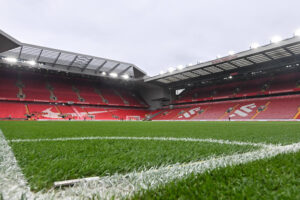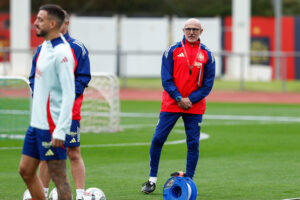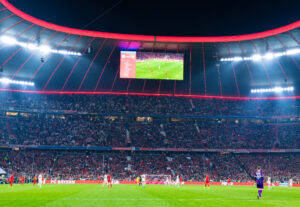You’ve got feel for Brighton this year, given how good they are at creating chances. In terms of points they should have from the quality of chances made, they are the fifth strongest team in the league, as per Understat. Chance conversion is Brighton and Hove Albion’s biggest problem.
But how can this be, when they’ve been marooned in the bottom half virtually all year? Well, that’s where the xG (or expected goals) algorithm comes into play. How Graham Potter must hate those two letters.
From a glance, it would appear that Brighton squander their chances with regularity. Indeed, this has often been the case for the Seagulls. Their accumulated xG stands at 43.0 at the time of writing, but they have only managed 33 goals this year. This means they’ve scored ten fewer goals than what would be expected, given the chances they create.
A match where this profligacy was on display was their away fixture against West Bromwich Albion. Brighton missed two penalties in this game, along with an open net. At the final whistle, Brighton had 3.28 xG, while West Brom had just 0.73. West Brom won 1-0.
A disappointing result for Brighton, but it was a great display of how they make openings for their attacking players.
If they’re crafting more openings than Tottenham Hotspur, Arsenal and Everton with far shallower resources, they must be doing something right. Furthermore, these teams may be able to learn something from their approach. Eventually, the chance conversion of the Brighton players will only increase.
Chance Conversion Brighton and Hove Albion’s Biggest Problem
Graham Potter’s Tactics Should Allow for Brighton Chance Conversion
The game plan at Brighton focuses on creating half-spaces for players to run into. These small pockets of space are generally formed by pulling defenders out of position just outside the 18-yard box.
Potter likes his full-backs to get forward whenever they can. In doing so, they create an overlap, leaving opposition defenders with a choice of whether to close them down and jeopardise the defensive structure or allow them to ping in a cross unopposed.
This allows room for wingers to cut inside, or for central midfielders to get forward. Potter likes both things to happen simultaneously, to keep the other team guessing. Even the centre-halves, Lewis Dunk and Ben White, have bombarded into the final third on occasion.
Recently, they have been adopting a 5-2-1-2 formation, with the wing-backs pushing up. This is to accommodate for the loss of the injured Tariq Lamptey, whose blistering pace has been noticeably missed.
This has allowed Leandro Trossard to be deployed as a number ten, meaning he can take advantage of both wide half-spaces. On the ball, he can also act as a creative pivot, to create a chance that should result in conversion by the Brighton forwards.
When playing their primary formation, 4-4-2, the wingers weren’t as liberal as they needed to be. This is because of Brighton’s fullbacks pushing up, meaning the wide players had to either cover for them or leave them exposed down that side.
Brighton are very difficult to defend against due to these reasons. They specialise in creating space around the penalty area, where an effective passer or dribbler can cause havoc.
Thankfully for Brighton, they have plenty of players like this.
Brighton’s Key Players
Every player in Potter’s system serves a purpose. Poor Neal Maupay, cast aside by most as an inexcusably terrible finisher, who Brighton would be better without. It’s true, shooting isn’t his strongest asset, but he’s in the team for his stellar hold-up play.
Compare him to someone who fulfils a similar role and is good at it, like Olivier Giroud. Maupay has created five more gilt-edged chances than his compatriot and has a far superior pass completion rate this season.
Giroud has played roughly half as many games as Maupay this year. However, even if you doubled Giroud’s total passes, chances created or goals, they would still not exceed that of Maupay’s. That’s a sign of an effective deep-lying forward.
You can’t talk about Brighton and not bring up Yves Bissouma. He’s energetic, pacey and is a joy to watch on the ball. Not only this, but he’s also strong defensively and can win the ball back in a heartbeat. More or less the complete modern midfielder, there aren’t many better at turning defence into attack than Bissouma.
They also have Steven Alzate, a composed and clever passer of the ball who likes to get forward. Brighton have a very solid base upon which they can build attacks, or flood the penalty area with extra bodies. They’re fluid, unpredictable and dynamic. Expect them both to have solid careers in professional football.
How Can Brighton Improve Chance Conversion?
Unfortunately, there is no straightforward answer, outside of the transfer market. When Brighton play with two up top, they are generally more effective. A better strike partner for Maupay would be ideal.
Some poor soul at Brighton signed Danny Welbeck with the impression that he’s a good finisher. He isn’t and never has been. Welbeck’s inadequacy is a reason why Watford got relegated last year and it could’ve easily happened to Brighton, too. Four goals in 18 appearances really is a poor return for the poacher role he plays.
Natural finishers at the highest levels are highly sought after, so it’s difficult to name a player of significance they could sign as they’ll probably be beaten to the punch by a bigger club.
For example, Tammy Abraham, who is rumoured to be leaving Chelsea, would be a fantastic addition to Brighton’s squad. However, it’s extremely unlikely he’ll end up there, given he’s already been linked with Leicester.
How about Adam Armstrong? He’s quick, good on the ball and is a smart finisher. Blackburn want a relatively affordable £30 million for him, but with reported interest from West Ham, he’s unlikely to end up at Falmer Stadium.
Their 5-2-1-2 formation seems like a possible solution, as it allows the number ten to break into the box more often. Sometimes, that one extra player in or around the box can make the difference.
This setup seems to be the most realistic answer. It allows them to take advantage of the half-spaces, while not sacrificing too much defensively. While they remain in the Premier League, they can slowly build their way towards being a top side. Potter is doing great things at Brighton and hopefully, he’ll be acknowledged for it and Brighton will improve their chance conversion.
Main Photo
Embed from Getty Images






